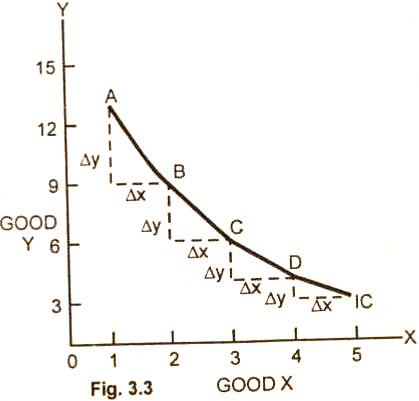Marginal Rate of
Substitution (MRS):
Definition and Explanation:
The concept of marginal rate substitution (MRS) was
introduced by Dr. J.R. Hicks and Prof. R.G.D. Allen to take the place of the
concept of diminishing
marginal utility. Allen and Hicks are of the opinion that
it is unnecessary to measure the utility of a commodity. The necessity is to
study the behavior of the consumer as to how he prefers one commodity to another
and maintains the same level of satisfaction.
For example, there are two goods X
and Y which are not perfect substitute of each other. The consumer is prepared
to exchange goods X for Y. How many units of Y should be given for one unit of X
to the consumer so that his level of satisfaction remains the same?
The rate or
ratio at which goods X and Y are to be exchanged is known as the marginal rate
of substitution (MRS). In the words of Hicks:
“The marginal rate of substitution of X
for Y measures the number of units of Y that must be scarified for unit of X
gained so as to maintain a constant level of satisfaction”.
Marginal rate of
substitution (MRS) can also be defined as:
“The ratio of exchange between small
units of two commodities, which are equally valued or preferred by a consumer”.
Formula:
MRSxy = ∆Y
∆X
It may here be noted that the marginal rate of
substitution (MRS) is the personal exchange rate of the consumer in contrast to
the market exchange rate.
Schedule:
The concept of MRS can be easily explained with the
help of schedule given below:
Marginal Rate of Substitution
|
Combination |
Good
X |
Good
Y |
MRS
of X for Y |
|
1 |
1 |
13 |
-- |
|
2 |
2 |
9 |
4 : 1 |
|
3 |
3 |
6 |
3 : 1 |
|
4 |
4 |
4 |
2 : 1 |
|
5 |
5 |
3 |
1 : 1 |
In the table given above, all the five combinations
of good X and good Y give the same satisfaction to the consumer. If he chooses
first combination, he gets 1 unit of good X and 13 units of good Y.
In the
second combination, he gets one more unit of good X and is prepared to give 4
units of good Y for it to maintain the same level of satisfaction. The MRS is
therefore, 4:1.
In the third combination, the consumer is willing to sacrifice
only 3 units of good Y for getting another unit of good X. The MRS is 3:1.
Likewise, when the consumer moves from 4th to 5th
combination, the MRS of good X for good Y falls to one (1:1). This illustrates
the diminishing marginal rate of substitution.
Diminishing
Marginal Rate of Substitution:
In the above schedule, we have seen that as the
consumer moves from combination first to fifth, the rate of substitution of good
X for good Y goes, down. In other words, as the consumer has more and more units
of good X, he is prepared to forego less and less of good Y.
For instance, in
the 2nd combination, the consumer is willing to give 4 units of good
Y in exchange for one unit of good X, in the fifth combination only one unit of
Y is offered for obtaining one unit of X.
This behavior showing falling MRS of
good X for good Y and yet to remain at the same level of satisfaction is known
as diminishing marginal rate of substitution.
Diagram/Figure:
The concept of marginal rate of substitution (MRS) can also be illustrated with the
help of the diagram.

In the fig. 3.3 above as the consumer moves down
from combination 1 to combination 2, the consumer is willing to give up 4 units
of good Y (∆Y) to get an additional unit of good X (∆X).
When the consumer
slides down from combinations 2, 3 and 4, the length of ∆Y becomes smaller and
smaller, while the length of ∆X is remain the same. This shows that as the stock
of the consumer for good X increases, his stock of good Y decreases.
He,
therefore, is willing to give less units of Y to obtain an additional unit of
good X. In other words, the MRS of good X for good Y falls as the consumer has
more of good X and less of good Y. The indifference curve IC slopes downward
from left to the right. This means a negative and diminishing rate of
substitution of one commodity for the other.
Importance
of Marginal Rate of Substitution (MRS):
(i) Measures utility ordinally: The concept
of MRS is superior to that of utility concept because it is more realistic
and scientific than the theory of utility. It does not measure the utility
of a commodity in isolation without reference to other commodities but takes
into consideration the combination of related goods to which a consumer is
interested to purchase.
(ii) A relative concept: The concept of
marginal rate of substitution has the advantage that it is relative and not
absolute like the utility concept given by Marshall. It is free from any
assumptions concerning the possibility of a quantitative measurement of
utility.
Relevant Articles:
|